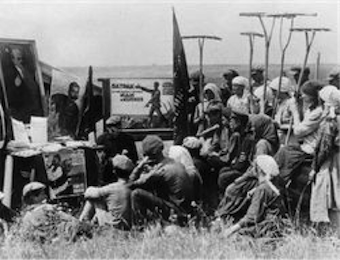

|
Collectivization  Forming a collective farm Collectivization was the first 'great break' forced through by Stalin as part of the Five Year Plan. It destroyed a way of life that had developed over many centuries. Millions of people were uprooted from their homes and dispersed across the Soviet Union. This nomadic population was the main labour force of Stalin's revolution, filling the great cities and industrial building-sites, the labour camps and 'special settlements' of the Gulag. Although it began with the 'battle for grain', collectivization was driven less by economic motives than by mistrust of the peasantry. Marxist ideology had taught the Bolsheviks to see the peasants as a 'petty bourgeois' relic of the old society. Peasants were too tied to patriarchal customs, too imbued in the individualistic principles of free trade and private property, and too wedded to the family and its farm, ever to be fully socialized. As the Civil War had shown, the peasants would remain a threat to the Soviet regime as long as they controlled the food supply. The grain crisis of 1927-28 renewed fears of a 'kulak strike' which Stalin played upon to overturn the NEP and force through the inflated figures of the Five Year Plan against the opposition of Bukharin and others on the Right of the party trying to prevent a rupture with the peasantry by arguing for slower rates of industrialization. Emboldened by the Urals-Siberian method, Stalin moved towards a policy of forced collectivization to secure the state's control of food production and remove the 'kulak threat' once and for all. He spoke with growing optimism about the potential of large-scale mechanized collective farms. Statistics showed that the few such farms already in existence had a much larger marketable surplus than the small agricultural surpluses produced by the peasant family farms. But these farms were hardly representative of the kolkhoz sector which was mainly without tractors in 1929. Thousands of Komsomol and Party activists were sent into the countryside to agitate for the collective farms. Reinforced by army and police units, they used coercive measures to herd the peasants into the collective farms. In one Siberian village, for example, the peasants were reluctant to accept the motion to join the collective farm. Troops were brought in and those opposed were asked to speak: no one dared, so it was declared that the motion had been 'passed unanimously.' |
© 2014 Orlando Figes | All Rights Reserved